Wednesday 29 April 2015
Weekly What Bird Wednesday
Thank you for joining me for W.W.B.W. once again! Last week there was a substantial amount of guesses. Josiah guessed right! It was a Northern Shoveler! Here is this week's picture!
Other W.W.B.W. posts*:
Birds In Your Backyard
Bird Boy
The Cats and the Birds
*Posts may not be up yet.
Tuesday 28 April 2015
B.O.T.D. Gray Partridge
Gray Partridge (Perdix perdix)
 |
| birding.bc.ca |
Native to western Eurasia, Gray Partridges were released in Canada in the early 1900s as game birds. Secretive and shy most of the year, the are rarely seen in the open. Watch for them in the morning or evening, when they venture onto quiet roads, or in winter, when they sometimes forage beneath rural bird feeders. When flushed a covey of will burst into flight, flapping furiously and dispersing in all directions, a tactic intended to confuse predators. Although Gray Partridges are relatively hardy birds, many parish in harsh weather, and some birds become trapped under layers of hardened snow while taking refuge from the cold.
The Gray Partridge has a high mortality rate and a short lifespan, but it makes up for these with its high reproductive capability. An average clutch size is about 16 eggs, and nests with more than 20 eggs are often found. When incubating her eggs, the female will sit tightly on her nest and risk being stepped on rather than attracting attention.
Like other seed eating birds, the Gray Partridge regularly swallows small amounts of gravel to help crush hard seeds. The gravel accumulates in the bird's gizzard, a muscular pouch of the digestive. This bird was once known as "Hungarian Partridge," and coveys of Gray Partridges are still called "Huns" by many hunters and birding enthusiasts.
Reader's Digest Publications: Birds of Canada
Monday 27 April 2015
Killdeers
B.O.T.D. White-Throated Sparrow
White-Throated Sparrow (Zonotrichia albicollis)
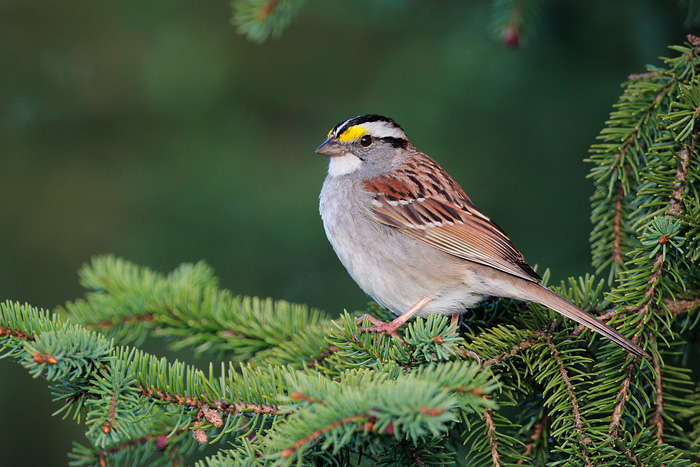 |
| Tringa.org |
The white-throated sparrow's song may not be the most glorious of sparrow melodies, but it is probably the best known simply because more people hear it. Although white-throats nest chiefly across the rural expanses of Canada, they winter through much of the eastern and southern United States - and they sing all winter long. They sometimes seem to be singing absentmindedly, it's true, but from March into May, when the last migrants leave, white-throats sing with real energy and purpose.
Their song is a simple one, often imitated by birders, and a passable rendition of it will bring the birds flitting through bushes in curious interest, craning their necks and peering about with bright eyes to discover the new arrival with the strange accent. White-throats and other small birds can also be called by "squeaking" - a sound make by a person kissing the back of his hand. Because the sounds are like those of a baby bird in distress, this kind of calling works especially well during the nesting season: parents come flocking, and birders have a chance to see species they might otherwise miss. But, understandably enough, squeaking also upsets the birds and can disrupt the care of their fledglings. Needless to say, therefore, it is a technique to be used with restraint and common sense.
Reader's Digest: Book of North American Birds
Friday 24 April 2015
Lockport
Today, as we had a day off from school, our family went on a day trip. We went through several towns and finally ended up at Lockport. Here are some Pelican pics from the trip.
B.O.T.D. Bay Breasted Warbler
Bay-Breasted Warbler (Dendroica castanea)
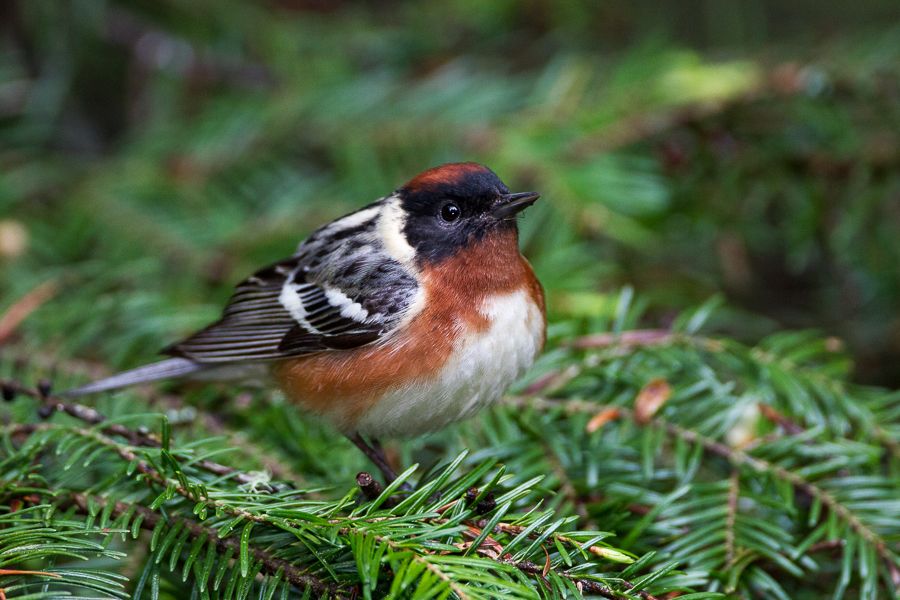 There's nothing like a plague of spruce budworms to make this warbler's day. Such outbreaks occur cyclically in northern conifer stands where the bay-breasted warblers nest, and can denude vast tracks of spruce and fir. Inflicting the damage are voracious budworm larvae, pests that have been a bane of lumbermen since the early 1900s. Bay-Breasted Warblers often react to the infestations by creating a population boom of their own making to take advantage of the sudden insect bounty.
There's nothing like a plague of spruce budworms to make this warbler's day. Such outbreaks occur cyclically in northern conifer stands where the bay-breasted warblers nest, and can denude vast tracks of spruce and fir. Inflicting the damage are voracious budworm larvae, pests that have been a bane of lumbermen since the early 1900s. Bay-Breasted Warblers often react to the infestations by creating a population boom of their own making to take advantage of the sudden insect bounty.
Showing true team spirit, nesting bay-breast scale down their normal territorial requirements so that more of their kind can squeeze into a budworm-infested area. The prodigious appetites of the additional nestlings are satisfied by an abundant supply of this protein-rich food. The number of bay-breasted warblers produced during such years sometimes exceeds six times the region's annual norm.
Inevitably, the budworms begin eating themselves out of house and home, and the infestation subsides or ends abruptly. Bay-Breasted Warblers, whose numbers have swollen to peak levels during the budworm explosion, find slim picking after the decline. As a result, their numbers, too drop to normal levels, and a more stable bird-insect balance returns to the northern woodlands.
Reader's Digest: Book of North American Birds
Thursday 23 April 2015
B.O.T.D. Red Knot
Red Knot (Calidris canutus)
 Imagine a beach so densely packed with shorebirds that sunlight is blocked from the sand. If that beach were on Delaware Bay in mid-May, the shorebirds - numbering in the hundreds of thousands - would be red knots.
Imagine a beach so densely packed with shorebirds that sunlight is blocked from the sand. If that beach were on Delaware Bay in mid-May, the shorebirds - numbering in the hundreds of thousands - would be red knots.
Separating New Jersey from Delaware on a coastline pressured by rapid suburban growth, Delaware Bay serves migrating knots as a crucial stepping-stone. En route to the Arctic from their South American wintering grounds, these chunky "beach robins" time their arrival to coincide with the breeding cycle of the bay's horseshoe crabs. Every May hordes of these ancient invertebrates haul themselves from the surf to deposit eggs by the millions in holes they have scooped in the sand. Knots, ruddy turnstones, and other shorebirds depend on these eggs to refuel their northward flights. The birds stay several weeks, gorging on the eggs from dawn until dusk to increase their body weight by 40% or more. Finally sated, they whirl off again in huge clouds toward the Arctic.
How many birds can convene on Delaware Bay? During the month of May alone, a million birds may comb the bay's egg-laden shores. On a given day during that period, more than 80% of North America's Red Knots - and half its ruddy turnstones - may join ranks there in one of the world's most awe inspiring congregations of wildlife.
Reader's Digest: Book of North American Birds
Wednesday 22 April 2015
Weekly What Bird Wednesday
 Thank you for joining me for W.W.B.W. once again! Last week there was a substantial amount of guesses. Bird Boy and Grietje guessed right! It was a Fox Sparrow. Here is this week's clue:
Thank you for joining me for W.W.B.W. once again! Last week there was a substantial amount of guesses. Bird Boy and Grietje guessed right! It was a Fox Sparrow. Here is this week's clue:Male bird has a deep green head with large wide black bill with chestnut sides and white breast and belly. It has a blue speculum.
Other W.W.B.W. posts*:
Birds In Your Backyard
Bird Boy
The Cats and the Birds
*Posts may not be up yet.
Tuesday 21 April 2015
B.O.T.D. Swainson's Hawk
Swainson's Hawk (Buteo swainsoni)
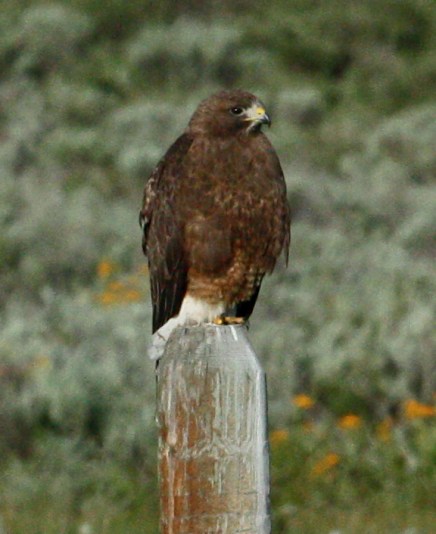 The farmer directs the mower through his field. Crickets and grasshoppers spring for safety as he passes. In the wake of the tractor, where the blades have passed and the grass is cropped short, a dozen russet-bibbed birds scramble and dance. Are they injured? Hardly. The birds are reaping the bounty of insects and small rodents exposed by the mower. The farmer does the work. The Swainson's hawk repays him for his kindness by consuming the creatures that consume his crops.
The farmer directs the mower through his field. Crickets and grasshoppers spring for safety as he passes. In the wake of the tractor, where the blades have passed and the grass is cropped short, a dozen russet-bibbed birds scramble and dance. Are they injured? Hardly. The birds are reaping the bounty of insects and small rodents exposed by the mower. The farmer does the work. The Swainson's hawk repays him for his kindness by consuming the creatures that consume his crops.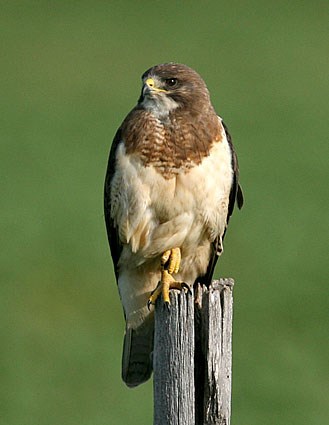 |
| Light Morph |
Among the world's long-distance champions, Swainson's hawks nest as far north as Alaska and winter on the plains of Argentina. In March, Swainson's hawks by the thousands pour across the Rio Grande from Mexico into Texas. When evening comes, the great flocks descend. In the morning, when the sun begins drawing thermals aloft, the birds rise up: dozens, scores, hundreds, thousands of Swaison's funnel skyward. The swirling tornadoes of birds sweep north and fan out across the western states. As the miles and the days fall behind, the great migratory flocks diminish. One by one, the birds reach their nest sites across the western United States and Canada. The business of raising young consumes the summer; by August the task is done, and the birds turn southward. Another exodus of these endurance champions has begun.
Reader's Digest: Book of North American Birds
Monday 20 April 2015
B.O.T.D. Hoary Redpoll
Hoary Redpoll (Acanthis hornemanni)
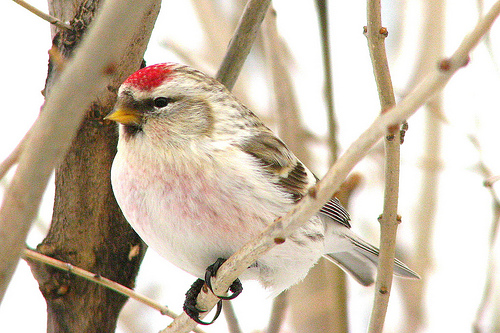 Common Redpolls and Hoary Redpoll can be confusing to differentiate because they look alike, share similar ranges and have similar songs and calls. The Hoary Redpoll is almost always seen with flocks of Common Redpolls and is generally paler and less streaked, with a stubbier bill. Some Hoary Redpolls are nearly impossible to differentiate from Commons, however, because of individual variation within both species and some overlap in identifying features. Both redpoll species are remote northern nesters and "predictable unpredictable" winter visitors to southern Canada. Like many finches, they can be abundant one year and almost absent the next. In the south, they tend to be more abundant every second winter, reflecting cyclic lows and highs in seed availability in their normal (northern) range. Things were much simpler when the two redpolls were considered a single species.
Common Redpolls and Hoary Redpoll can be confusing to differentiate because they look alike, share similar ranges and have similar songs and calls. The Hoary Redpoll is almost always seen with flocks of Common Redpolls and is generally paler and less streaked, with a stubbier bill. Some Hoary Redpolls are nearly impossible to differentiate from Commons, however, because of individual variation within both species and some overlap in identifying features. Both redpoll species are remote northern nesters and "predictable unpredictable" winter visitors to southern Canada. Like many finches, they can be abundant one year and almost absent the next. In the south, they tend to be more abundant every second winter, reflecting cyclic lows and highs in seed availability in their normal (northern) range. Things were much simpler when the two redpolls were considered a single species.
Redpolls are widely adapted to life in the cold. They have a high level of food intake, in part because of a special storage pouch in the esophagus (the esophageal diverticulum), which allows them to carry large quantities of energy-rich seeds.
Lone Pine Publications: Birds of Canada
Saturday 18 April 2015
Spring is Here!
As we were getting ready for school on Wednesday, another vagrant of spring showed up in a sapling nearby!
Friday 17 April 2015
B.O.T.D. Baird's Sparrow
Baird's Sparrow (Ammodramus bairdii)
 Baird's Sparrows are frustrating grassland denizens. Just when the form of the sparrow drifts into focus through your binoculars, the bird dives out of view from its perch. Baird's Sparrows sing atop grasses stems and low shrubs, but when they stop singing, they are almost impossible to find.
Baird's Sparrows are frustrating grassland denizens. Just when the form of the sparrow drifts into focus through your binoculars, the bird dives out of view from its perch. Baird's Sparrows sing atop grasses stems and low shrubs, but when they stop singing, they are almost impossible to find.
The Baird's Sparrow is a bird of native grasslands with an unusually small nesting distribution in the southern Canadian Prairies and extreme northern Great Plains states. It favours lush areas rather than grazed, short-grass prairie habitat. During years of drought, the Baird's Sparrow is now uncommon and declining throughout its range. Agriculture has eliminated much of the prairie it is reliant on and continues to reduce remaining grassland tracts. Baird's Sparrow was the last bird collected and described by Audubon for his classic Birds of North America. If you think this species is difficult to find and recognize now, consider that it took 30 years for a second ornithologist to "rediscover" Baird's Sparrow after is was first described.
Lone Pine Publications: Birds of Canada
Thursday 16 April 2015
B.O.T.D. Hammond's Flycatcher
Hammond's Flycatcher (Empidonax hammondii)
 High atop a spruce clinging to the flanks of the northern Rockies, a Hammond's flycatcher sits and waits. Wings and tail flicking, feet clamping upon its perch, the bird fairly vibrates like a slingshot at full draw. Suddenly it darts forth. The wide flycatcher bill opens and closes with an audible snap - and a flying ant disappears within. Then, as it tethered by an invisible elastic, the feathered projectile snaps back to its launch point, where it sits, fidgeting nervously, and waits for another victim to pass.
High atop a spruce clinging to the flanks of the northern Rockies, a Hammond's flycatcher sits and waits. Wings and tail flicking, feet clamping upon its perch, the bird fairly vibrates like a slingshot at full draw. Suddenly it darts forth. The wide flycatcher bill opens and closes with an audible snap - and a flying ant disappears within. Then, as it tethered by an invisible elastic, the feathered projectile snaps back to its launch point, where it sits, fidgeting nervously, and waits for another victim to pass.
The Hammond's is a bird for the heights, foraging int eh higher branches of tall western evergreens. In the warmer, southern reaches of its nesting range, the bird's love of high places may carry it to elevations above 10,000 feet - a penchant that helps to distinguish from the dusky flycatcher. This near-twin of the Hammond's shuns high places and favours drier, more open woodlands. Not quite so nervous as the Hammond's, dusky flycatchers seem able to hold their wing flickering in check, but even the strongest willed dusky must surrender to a periodic twitch of the tail.
The high-strung Hammond's must be anxious about being separated from its nesting territory, too. In the spring it arrives uncommonly early - often migrating with those vanguards of spring, the hardy kinglets. In the fall it lingers longer than most other flycatchers - far longer than mights seem prudent for a bird that catches insects for a living.
Cornell Lab: Hammond's Flycatcher
Reader's Digest: Book of North American Birds
Cornell Lab: Hammond's Flycatcher
Reader's Digest: Book of North American Birds
Wednesday 15 April 2015
Weekly What Bird Wednesday
 Thank you for joining me for W.W.B.W. once again! Last week there was one guess... William got it right! The answer was the House Finch. Here is this week's clue:
Thank you for joining me for W.W.B.W. once again! Last week there was one guess... William got it right! The answer was the House Finch. Here is this week's clue:This bird is stocky, rusty brown, streaky with underlying grey. About 6-7 inches long.
Hint: It is a sparrow ;-)
Other W.W.B.W. posts*:
Birds In Your Backyard
Bird Boy
The Cats and the Birds
*Posts may not be up yet.
Tuesday 14 April 2015
B.O.T.D. Pine Warbler
Pine Warbler (Dendroica pinus)
The names of many birds are illogical, if not downright misleading, but in this case a more suitable one could scarcely have been chosen. Pitch pine, jack pine, Norway pine, red pine, white pine, scrub pine - very types do not figure prominently in their lives of pine warblers. Except during spring and fall migrations. these little birds are rarely spotted too far away from their favourite trees.
Their sturdy nests are found well out on a horizontal pine limb, hidden gin tufts of needles at the very tip of a branch or among a cluster of cones. They are built of pine bark, pine needles, and tiny pine twigs, all held together with spider or caterpillar silk (gleaned most likely from around the tree) and lined with plant down, fur, and feathers that also probably come from eh immediate vicinity.
The pine warblers' food consists mainly of the insects, spiders, and their kin whom the birds share the pine trees. Daily they scour the branches, twigs and needles and creep over the bark searching for their prey - not with the single-minded concentration of brown creepers, but in much the same manner, with their bodies pressed low and feathers brushing the bark. Sometimes their bright plumage becomes streaked with the pitch, or resin, that rubs off on them, and it is clearer that ever that these warblers are a product of the pines.
Reader's Digest: Book of North American Birds
Monday 13 April 2015
Elm Creek
 On Saturday, April 11th we went to Elm Creek (near Carman). It was an amazing experience adding three species to my 2015 list and one lifer... the trumpeter swan. Trumpeter Swans, Long-Eared Owls, and Wild Turkeys. It was much fun as we also did fireworks and tracked down some howling coyotes. We also saw a flock of hundreds of migrating blackbirds and grackles. Picture coming soon.
On Saturday, April 11th we went to Elm Creek (near Carman). It was an amazing experience adding three species to my 2015 list and one lifer... the trumpeter swan. Trumpeter Swans, Long-Eared Owls, and Wild Turkeys. It was much fun as we also did fireworks and tracked down some howling coyotes. We also saw a flock of hundreds of migrating blackbirds and grackles. Picture coming soon.B.O.T.D. American Wigeon
American Wigeon (Anas americana)
 What some birds won't go through for a taste of wild celery. Take the American wigeon, a duck with diving limitations that would seem to rule out its enjoyment of a plant that grows deep in the water. But the wigeon has a simple solution: let other ducks get the celery, then grab some of it. The unwitting donors are redheads, scaups, and canvasbacks - all diving birds adept at rooting up celery from the bottom. Tailoring its migration routes and wintering locations to theirs, the crafty wigeon shadows them like pilot fish trailing a shark.
What some birds won't go through for a taste of wild celery. Take the American wigeon, a duck with diving limitations that would seem to rule out its enjoyment of a plant that grows deep in the water. But the wigeon has a simple solution: let other ducks get the celery, then grab some of it. The unwitting donors are redheads, scaups, and canvasbacks - all diving birds adept at rooting up celery from the bottom. Tailoring its migration routes and wintering locations to theirs, the crafty wigeon shadows them like pilot fish trailing a shark.
As a flock of redheads feeds over a celery bed, a redhead dives - and a nearby wigeon springs into action. Anticipating where its victim will surface, the wigeon swims over and waits. When the redhead pops up with a bill-full of celery stems, the opportunist brazenly snatches a strand.
Is the redhead outraged? Does it drive the wigeon away? On the contrary, diving dicks put upon by wigeons accept their role as providers with evident tolerance. Perhaps they can sense that wigeons are quick to sense trouble and warn them of danger. More restless than any other ducks, wigeons impart their alarm to the divers around them, leaping from the water in a flurry of alarm quacks and rattling wings. Surely insurance like that is worth a celery stalk or two.
Reader's Digest: Book of North American Birds
Friday 10 April 2015
The Art of Mimicry
 This morning as I was walking outside to my morning class I stumbled upon a little songster up in a tree. This little bird was the European Starling, a species introduced to Manitoba in the 1900s. It has since spread all over Canada and North America and there is little place you can go to get away from these pests to many who do not realize these birds' talent as songsters. Anyway, as I was walking a Blue Jay flew over head and screamed his jay-jay-jay! I looked up and as he flew behind the school another 'jay' screamed. Then came the warble of a robin from the same spot along with a few whistles and house sparrow call-notes. I was fooled by them all... trying desperately to locate the source. The amazing (and frustrating)
This morning as I was walking outside to my morning class I stumbled upon a little songster up in a tree. This little bird was the European Starling, a species introduced to Manitoba in the 1900s. It has since spread all over Canada and North America and there is little place you can go to get away from these pests to many who do not realize these birds' talent as songsters. Anyway, as I was walking a Blue Jay flew over head and screamed his jay-jay-jay! I looked up and as he flew behind the school another 'jay' screamed. Then came the warble of a robin from the same spot along with a few whistles and house sparrow call-notes. I was fooled by them all... trying desperately to locate the source. The amazing (and frustrating) part was that the starling emitted multiple sounds at once; adding to his award-winning theatrical performance.
B.O.T.D. Yellow-Headed Blackbird
Yellow-Headed Blackbird (Xanthocephalus xanthocephalus)
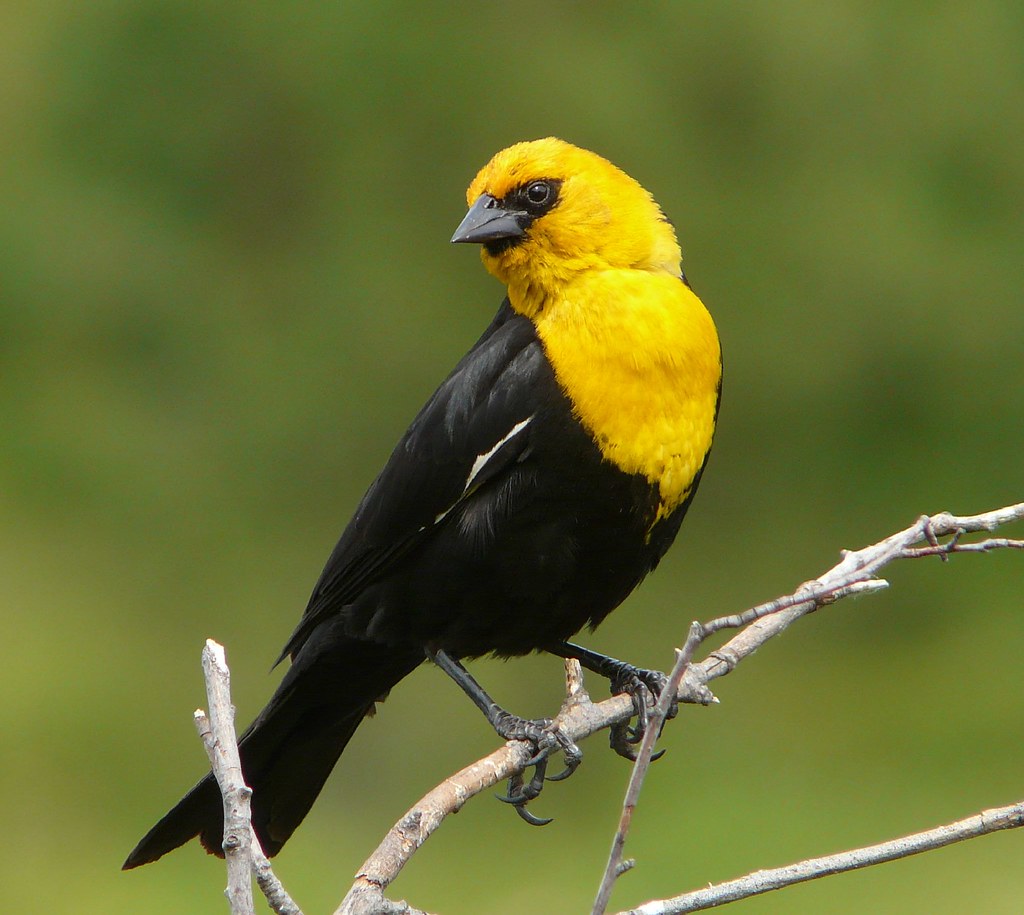 In a Wyoming marsh a burly blackbird hitches himself to a bulrush stalk, his golden hood glistening in the sun. Slowly, deliberately, he fans his glossy tail. With the eyes of his intended upon him, he opens his wings in a dramatic gesture of appeal. Then, bowing low, till his golden crown is nearly flush with his tail, he opens his mouth and emits the nastiest sound ever heard from a bird's mouth.
In a Wyoming marsh a burly blackbird hitches himself to a bulrush stalk, his golden hood glistening in the sun. Slowly, deliberately, he fans his glossy tail. With the eyes of his intended upon him, he opens his wings in a dramatic gesture of appeal. Then, bowing low, till his golden crown is nearly flush with his tail, he opens his mouth and emits the nastiest sound ever heard from a bird's mouth.Even the most generous critics concede that as a vocalist, the yellow-headed blackbird is unmusical - and a few might agree with W. L. Dawson, who described the song as "a wail of despairing agony which would do credit to a dying catamount." It seems that no one who has written about this bird of marshes and reedy lakes can resist commenting on the disparity between its spectacular courtship display and its horrific, croaking voice.
Yellow-heads nest in colonies, some quite large. They favour deeper water than the smaller red-winged blackbirds, and where the two birds occur together, the red-wings are shunted to the shallower marshland edge. Deep water is a deterrent to such predators as raccoons and skunks, while colony life is a defence against marauding hawks and crows. Any harrier that approaches a colony to closely must soon contend with an angry black and yellow crowd of birds. It is a wise hawk that retreats before it is put to rout.
Cornell Lab: Yellow-Headed Blackbird
Reader's Digest: Birds of North America
Thursday 9 April 2015
B.O.T.D. Marbled Godwit
Marbled Godwit (Limosa fedoa)
To photograph birds is to sweat and swat flies, to stand for long hours waist-deep in swamp water, or to crouch even longer in freezing makeshift blinds. Allan Cruickshank knew these tortures. As one of America's leading bird photographers, Cruickshank expected the worst.
_-8.jpg) Them along came a marbled goodwill to make his life easy. Tawny like the grass that engulfed her, the mottled female was nearly invisible against the hollow of beaten-down grasses that holder four olive eggs. When Cruickshank approached, the bird scurried away. He built a blind and almost immediately, the bird returned. Perhaps, he hoped he would not need a blind. Perhaps this beautifully camouflaged shorebird - known for "sitting tight" while unknowing predators walked just inches away - would allow him to approach. This bird did that and more. To Cruickshank's amazement, his docile subject even allowed him to pick her up while he photographed the nest.
Them along came a marbled goodwill to make his life easy. Tawny like the grass that engulfed her, the mottled female was nearly invisible against the hollow of beaten-down grasses that holder four olive eggs. When Cruickshank approached, the bird scurried away. He built a blind and almost immediately, the bird returned. Perhaps, he hoped he would not need a blind. Perhaps this beautifully camouflaged shorebird - known for "sitting tight" while unknowing predators walked just inches away - would allow him to approach. This bird did that and more. To Cruickshank's amazement, his docile subject even allowed him to pick her up while he photographed the nest.
All that changed overnight, however. As soon as her eggs hatched the goodwill reacted hysterically to Cruickshank's presence, flying this way and that and berating him loudly before leading her young from the nest. Never again would the goodwill allow Cruickshank's approach. But the man had his pictures - and in contrast to most such projects, getting them had literally been a walk in the park.
Cornell Lab: Marbled Godwit
Reader's Digest: Birds of North America
Cornell Lab: Marbled Godwit
Reader's Digest: Birds of North America
Wednesday 8 April 2015
Mystery Bird!
 As I was driving home from piano lessons on Tuesday we flushed a bird out of its ditch. I did not have enough time to make an even rough identification. Here is what I know:
As I was driving home from piano lessons on Tuesday we flushed a bird out of its ditch. I did not have enough time to make an even rough identification. Here is what I know:I was 6-12 inches, appeared whitish to grey, flew like a ptarmigan or partridge and looked like an chunk of snow in a snowstorm. Keep in mind that I live in an area of open country with scattered brush.
Thanks, (J)
Weekly What Bird Wednesday
Thank you for once again joining me for W.W.B.W. Last week was a hard one and no one was right! The correct answer to last weeks was Lark Sparrow! Here is this week's clue:
It is a small song-bird with streaky brown feathers and a breast and throat that can range from red to yellow. Female is the same except without colourful breast.
Other W.W.B.W. posts:
Birds in Your Backyard
Bird Boy
The Cats and the Birds
It is a small song-bird with streaky brown feathers and a breast and throat that can range from red to yellow. Female is the same except without colourful breast.
Other W.W.B.W. posts:
Birds in Your Backyard
Bird Boy
The Cats and the Birds
Tuesday 7 April 2015
B.O.T.D. Yellow Rail
Yellow Rail (Caturnicops noveboracensis)
 Under a blanket of darkness, the Yellow Rail slips quietly through tall sedges, grasses and cattails, searching for food, This rather rare bird hide behind a cover of dense, marshy vegetation by day and is most active at night. It is almost always encountered through its distinctive and repetitive call, heard along marsh edges in spring. The male's territorial call, generally heard only in complete darkness, is a unique, repetitive, five-note tik, tik, tik-tik-tik, easily imitated by tapping two stones together. But catching a glimpse of these marsh phantoms is the ultimate challenge. When standing motionless, the rail's tawny yellow and dark stripes blend in perfectly with the marsh vegetation. And when required to, this bird can make itself "as thin as a rail," its laterally compressed body allowing it to effortlessly slip through tightly packed stands of marsh vegetation. Its large feet, which help the bird rest atop thin mats of floating plant materials, adds to the Yellow Rail's strange appearance.
Under a blanket of darkness, the Yellow Rail slips quietly through tall sedges, grasses and cattails, searching for food, This rather rare bird hide behind a cover of dense, marshy vegetation by day and is most active at night. It is almost always encountered through its distinctive and repetitive call, heard along marsh edges in spring. The male's territorial call, generally heard only in complete darkness, is a unique, repetitive, five-note tik, tik, tik-tik-tik, easily imitated by tapping two stones together. But catching a glimpse of these marsh phantoms is the ultimate challenge. When standing motionless, the rail's tawny yellow and dark stripes blend in perfectly with the marsh vegetation. And when required to, this bird can make itself "as thin as a rail," its laterally compressed body allowing it to effortlessly slip through tightly packed stands of marsh vegetation. Its large feet, which help the bird rest atop thin mats of floating plant materials, adds to the Yellow Rail's strange appearance.
Agricultural expansion has claimed a large share of this rail's habitat in southern Canada, and concerns regarding how low overall numbers and continuing habitat loss throughout its breeding range has resulted in its recent designation as a species of special concern in Canada.
Cornell Lab: Yellow Rail
Lone Pine Publications: Birds of Canada
Cornell Lab: Yellow Rail
Lone Pine Publications: Birds of Canada
Monday 6 April 2015
B.O.T.D. Black-Throated Gray Warbler
Black-Throated Gray Warbler (Dendroica nigrescens)
 Except for a tiny patch of yellow in front of each eye, the black-throated gray is somewhat of a drab warbler. But this colouring is to the bird's advantage. In its preferred habitat of young, more open conifer forests or regions of scrub growth such as juniper, pinyon, or manzanita, its streaky plumage of black, white and grey blends right in with the bray-green foliage.
Except for a tiny patch of yellow in front of each eye, the black-throated gray is somewhat of a drab warbler. But this colouring is to the bird's advantage. In its preferred habitat of young, more open conifer forests or regions of scrub growth such as juniper, pinyon, or manzanita, its streaky plumage of black, white and grey blends right in with the bray-green foliage.
In keeping with such a somber suit is this bird's businesslike manner of feeding. Particularly in spring, when oak worms are abundant, it forages with well-ordered zeal, methodically checking ever leaf and twig for these ubiquitous green caterpillars.
Its nest, too, is carefully crafted and a masterpiece of camouflage. Typical of most warblers' nurseries, it is a neatly woven cup of dried grasses and weathered weed stalks, usually lined with moss and feathers, sometimes with horse or other animal hair, where available. The bird very cleverly conceals the nest in a small clump of leaves, large enough to disguise it but not so obvious that a predator would look for something hidden there. Ever the cautious conservative, the black-throated gray will take all sorts of evasive action to avoid leading you to its nest. But if you should manage to find it, in a flash, the bird becomes a master of the theatrical arts, feigning fits or injury so convincingly, it deserves a standing ovation.
Cornell Lab: Black-Throated Gray Warbler Reader's Digest: Book of North American Birds
Sunday 5 April 2015
Successful Saturday
Joel and I got the chance of getting together on Saturday April 4th which turned out to be a great experience for both of us. It included seeing a Great-Horned Owl, Sparrow's, Nuthatches, Crows, Sparrows, Meadowlarks, Blackbirds, and Woodpeckers. We were able to add 4 bird's to my 2015 list and one to his.
And we definitely won't forget how many Canada Geese we saw which was a grand total of 752 in less than hour! We almost had no time left to reach our goal of 750 so in a last ditch effort we want in back field and counted 4 more to complete out goal.
To see was birds we saw go to the Bird Log; Apr 4th.
And we definitely won't forget how many Canada Geese we saw which was a grand total of 752 in less than hour! We almost had no time left to reach our goal of 750 so in a last ditch effort we want in back field and counted 4 more to complete out goal.
To see was birds we saw go to the Bird Log; Apr 4th.
Friday 3 April 2015
First Nesting Birds!
Today we spotted some Juncos flying to and from under our deck. We have been watching them for a while... now here are some pictures.
... and the crows
B.O.T.D. Bobolink
Bobolink (Dolichonyx orysivorus)
 Up from Brazil and Argentina come the bobolinks each spring, traveling in small flocks of smartly call males and sparrow drab females. They funnel up through Florida and on toward the North, feasting on dandelion seeds and filling the air with their bubbling conversations. These small flocks drop off on nesting grounds through the northern United States and southern Canada. They rear one brood of young and spend the rest of the summer bobbing about and going through a molt that leaves every bobolink wearing sparrow drab. Heading back south in the fall, they look like different birds - so much so that for years people thought they were.
Up from Brazil and Argentina come the bobolinks each spring, traveling in small flocks of smartly call males and sparrow drab females. They funnel up through Florida and on toward the North, feasting on dandelion seeds and filling the air with their bubbling conversations. These small flocks drop off on nesting grounds through the northern United States and southern Canada. They rear one brood of young and spend the rest of the summer bobbing about and going through a molt that leaves every bobolink wearing sparrow drab. Heading back south in the fall, they look like different birds - so much so that for years people thought they were.
They travel differently, too, forming mammoth flocks that feed on harvested grain fields and fallow land. For decades they swooped upon South Carolina rice plantations and grew as fat as little butterballs. And every fall they were killed by the tens of thousands to be sold and eaten as butter birds. So many were slaughtered that they have never recovered their vast numbers. But most of the rice fields are gone now, the birds are protected by laws, and most people know the autumn bitter birds are the springtime bobolinks that fill the air with their tinkling music.
Cornell Lab: Bobolink Reader's Digest: Book of North American Birds
Thursday 2 April 2015
Fort Whyte Alive
On Wednesday, April 1 I was able to go to Fort Whyte Centre where 162 bird species had been spotted. It was a very eventful afternoon and I wasn't dissapointed! I was able to add three species to my life list. An American Coot, a Ring-Necked Duck and a Burrowing Owl. Also that morning I saw a Clay-Colored Sparrow which made a total of four life list birds in one day! At the Center I was also able to see (not to my surprise) a ton of Canada Goose. I also spotted Mallards, Chickadees, Cackling Geese, Red-Tailed Hawks and much more. I got some pretty good shots of the Burrowing Owl which was probably my favorite bird of them all.
(Pictures Coming Soon)
(C)
(Pictures Coming Soon)
(C)
B.O.T.D. Upland Sandpiper
Upland Sandpiper (Bartramia longicauda)
After the multitudes of North America's passenger pigeons had all been slaughtered for market, commercial hunters turned their guns on the innumerable upland sandpipers that flourished across our vast, rolling grasslands. By the early 1900s, with no restrictions on the carnage, scarcely an upland sandpiper could be found anywhere on the plains. The sweet-voiced birds - which, simply by feeding themselves, must have saved the country from many a scourge of grasshoppers, army worms, weevils, and cutworms - were almost annihilated.
 Alarmed by the disappearance of so many birds, various states began to pass protective laws; but it was too late for some species and nearly so for others. Like all birds, upland sandpipers face many natural hazards - accidents, diseases, storms, and hungry predators, among others. In addition, they fly a difficult migration route of 7,000 to 8,000 miles - and are still hunted on their South American wintering grounds. Despite all this, the upland sandpipers have defied all odds and appear to be holding their own quite well across most of their large summer range.
Alarmed by the disappearance of so many birds, various states began to pass protective laws; but it was too late for some species and nearly so for others. Like all birds, upland sandpipers face many natural hazards - accidents, diseases, storms, and hungry predators, among others. In addition, they fly a difficult migration route of 7,000 to 8,000 miles - and are still hunted on their South American wintering grounds. Despite all this, the upland sandpipers have defied all odds and appear to be holding their own quite well across most of their large summer range.
Cornell Lab: Upland Sandpiper Reader's Digest: Book of North American Birds
Wednesday 1 April 2015
Weekly What Bird Wednesday
Thank you for joining me for W.W.B.W. once again! Last weeks bird was a Yellow-Bellied Sapsucker as William, Josiah, and Matthew guessed. I was told that my clues were too easy, so I chose a hard one! You are lucky cause I almost chose a sandpiper, but here is the clue:
I am a small brownish bird with a chestnut crown and cheek, a black eyestripe, moustache and jaw line. I also have pinkish feet. Male and female are identical.
Other W.W.B.W. posts*:
Birds In Your Backyard
Bird Boy
The Cats and the Birds
*The posts may not be up yet as this post is set to post at 6:30 Central Time.
I am a small brownish bird with a chestnut crown and cheek, a black eyestripe, moustache and jaw line. I also have pinkish feet. Male and female are identical.
Other W.W.B.W. posts*:
Birds In Your Backyard
Bird Boy
The Cats and the Birds
*The posts may not be up yet as this post is set to post at 6:30 Central Time.
Subscribe to:
Posts (Atom)

























